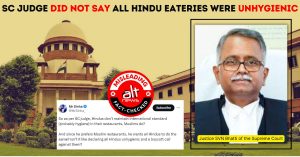Images of coins bearing figures of Hindu gods and goddesses have been posted by social media users, with the narrative that these were issued by the erstwhile East India Company during its rule in India.
“It is a coincidence that two anna coin in 1818 featured Sri Ram darbar on one side and a lotus flower on the other. It seems this was a message that Diwali will be celebrated in Ayodhya when lotus will be in power and Lord Ram’s grand temple will be built. This has now been proven true. (इसे एक संयोग ही कहा जायेगा 1818 में जो २ आना का सिक्का होता था उसमें एक तरफ.श्रीराम दरबार अंकित था और दूसरे । तरफ कमल का फूल बना हुआ था। ऐसा प्रतीत होता है ये संदेश था कि जब कमल का राज आएगा अयोध्या में तभी दीपोत्सव मनाया जाएगा एवं भगवान श्रीराम जी का भव्य ____ मंदिर बनेगा जो अब सच साबित हुआ है.)” – reads the complete message shared with the picture.
जय जय श्री राम सभी को राम राम जय सीता राम🙏🙏🙏🙏🙏
Posted by Bunty Pandit Amit on Monday, 22 February 2021
The photo of the coin is massively widespread on Facebook. One side of the coin bears the figure of the lotus and Om, the Hindu religious symbol. The value of the coin is mentioned to be ‘2 anna’, and the year 1818 is inscribed, apart from ‘East India Company’. The other side of the coin bears five figures, with the central figure shown as Lord Ram. The words ‘Sri Ram darbar’ are seen inscribed on the coin.
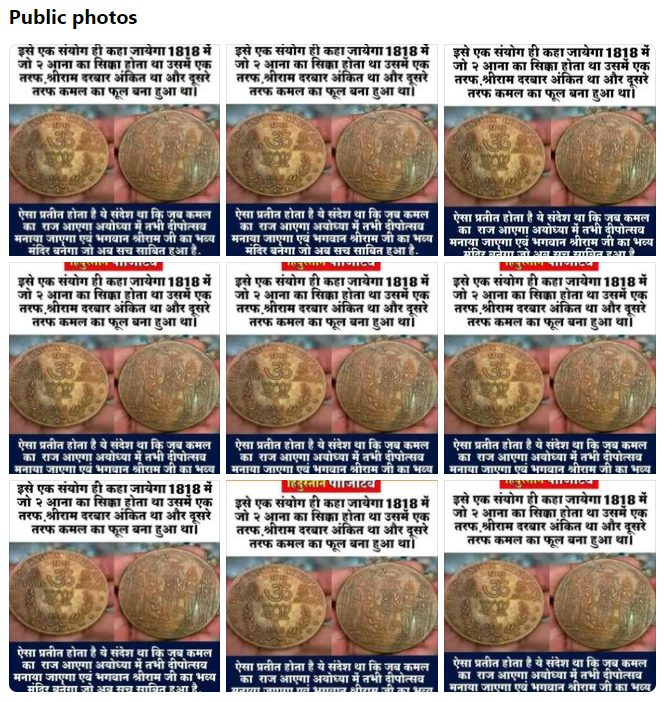
Viral since 2019
“Do you know that two anna coin was released in 1818 by East India Company; and you will be surprised to see the other side of the coin”, read the text shared with the image two years ago.
Do you know that two anna coin was released in 1818 by East India Company;
and you will be surprised to see the other side of the coin.श्रीराम राम रणकर्कश राम राम ।
श्रीराम राम शरणं भव राम राम ।। pic.twitter.com/kgFQZZYCXh— Ajit Doval Fan (@AjitKDoval_FAN) November 8, 2019
The pictures were posted with identical text by several Facebook users. Some users had even posted videos featuring these coins.
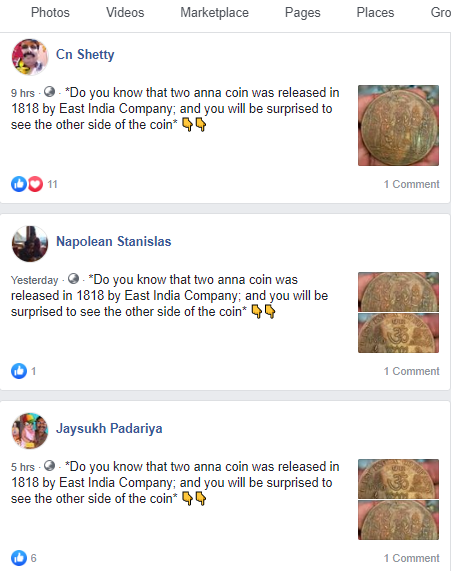
The images had also been shared with text in Tamil, which stated “முக்கிய செய்தி….. பகிரவும் அதிகம் 50 வருடம் ஆட்டம் போட்ட ஆட்டு மந்தைகளுக்கு இது சமர்ப்பணம் உன் பாட்டன் பூட்டன் காலத்திலே 2 நா நாணயத்தில் பிரிட்டிஷ் கவர்மெண்ட் கொடுத்த மகத்தான சாட்சி #இந்து_மதம் இது
@mkstalin மற்றும் ஓசி சோறு வீரமணி பல கிருஸ்துவ கம்பெனிக்கு சமர்ப்பணம்”.
முக்கிய செய்தி….. பகிரவும் அதிகம்
50 வருடம் ஆட்டம் போட்ட ஆட்டு மந்தைகளுக்கு இது சமர்ப்பணம்உன் பாட்டன் பூட்டன் காலத்திலே
2 நா நாணயத்தில் பிரிட்டிஷ் கவர்மெண்ட் கொடுத்த மகத்தான சாட்சி #இந்து_மதம்இது @mkstalin மற்றும் ஓசி சோறு வீரமணி பல கிருஸ்துவ கம்பெனிக்கு சமர்ப்பணம் pic.twitter.com/57enZ3fN12
— ஹரி சம்புவரையர் மாவட்டத்தான் 🇷🇴🔥 (@Hari42147154) November 6, 2019
As can be seen in the above tweet, the image on the left shows a coin with the lotus symbol, whereas the coin on the right represents five figures, with the words ‘Jai Shri Ram’ inscribed at the bottom. The images with accompanying text in Tamil were posted on Facebook. They had also been uploaded on the Alt News mobile app for verification.
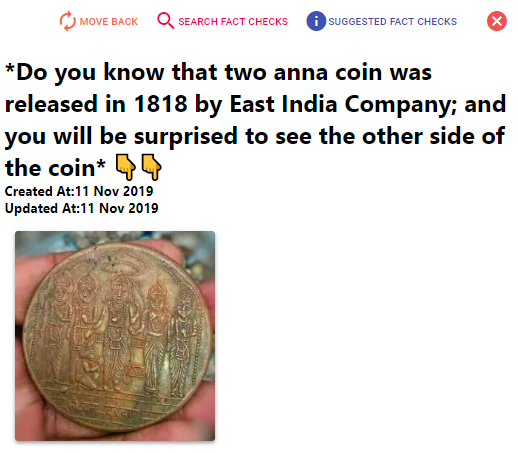
“IMAGES IN CIRCULATION ARE FANTASY CREATIONS”
Alt News’s fact-check found that the images in circulation do not represent coins minted by the British East India company. Alt News spoke to numismatist and author Mohit Kapoor for more information. Mr. Kapoor is the regional secretary for the South Asian chapter of the Oriental Numismatic Society. He said, “All of these are fantasy issues as the East India company never minted any coins of this type. Moreover the years that these pieces have on them 1616, 1717 and 1818 had hand struck coinage whereas these fantasy pieces are all struck using machines. Another thing that clearly points out that these are fantasy issues is the denominations that are inscribed on these pieces. Specific denominations were struck in specific metals, a 2 Anna would be in silver and not in copper. In fact the earliest example of a 2 Anna in Copper-Nickel alloy is the one struck in 1919, which too saw stiff resistance by the general population as they were used to the denomination being in Silver.”
COINAGE OF THE EAST INDIA COMPANY
Since the images in circulation supposedly show coins issued by the company in 1818, we shall consider the late 18th and early 19th centuries as our reference period, in order to probe the nature of coinage under the East India company.
With the royal charter granted by Queen Elizabeth I on December 31, 1600, the East India company embarked on a quest for commercial and imperial expansion. The company became a force to reckon with in the subcontinent after the victory at the Battle of Plassey in 1757, and eventually cemented its rule with the establishment of the Calcutta, Madras and Bombay presidencies. The coining of money was the logical outcome of the consolidation of territory, serving as proof of sovereignty in a newly conquered land. However, the company’s initial approach was atypical. The coins issued by the East India Company in the late 18th and early 19th centuries acknowledged the supremacy of the native rulers, with inscriptions in Persian or other native languages including Hindi, struck either in the name of the Mughal emperor or other native rulers and princes. This was particularly true of the Bengal and Bombay presidencies. Three kinds of currencies were in circulation in the territories of the East India Company, pertaining to the three presidencies of Madras, Calcutta and Bombay where the company had established mints in several towns. It was only later in 1835 that a uniform system of coinage was adopted.
An article by J.M.C Johnston titled ‘Coinage of the East India Company’, published in The Numismatic Chronicle and Journal of the Numismatic Society (Fourth series, Vol.3) states, “Under the third period, which commences with the administration of the Company in Bengal 1765, when the rule of the emperor Shah Alam was purely nominal, it is difficult to make any distinction between coins issued in his name by provincial governors, those issued at mints under native control under the authority of the Company, and coins struck at the company’s own mints.”
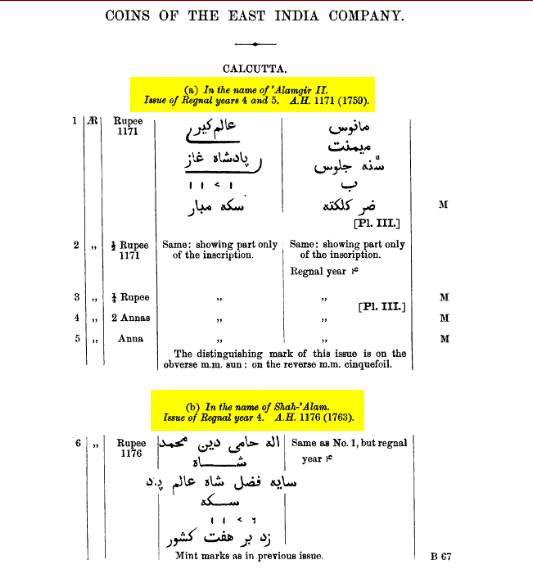
Posted below are some illustrations of the coinage of the East India company in the late 18th and early 19th centuries. These coins were minted in the Bengal presidency. As can be seen, the coins bear the Persian, Bengali and Hindi languages. The value of these coins is one pice. Also, these coins are clearly hand-struck, unlike the machine-made coins represented by the viral images. The coins are made of copper.
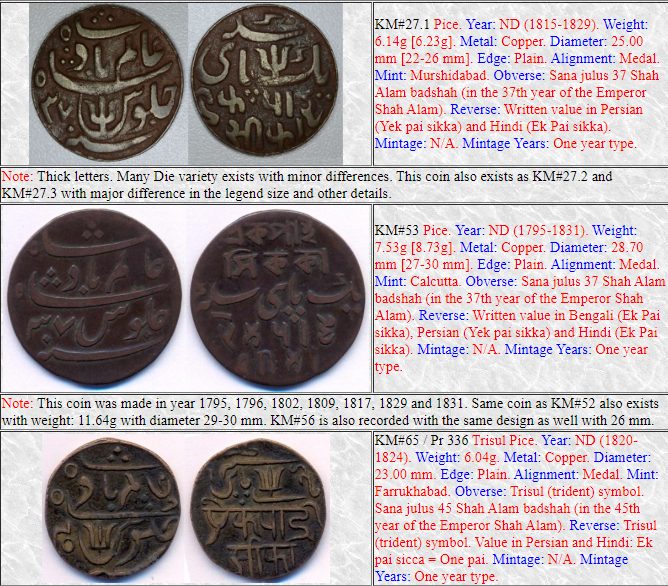
Insofar as the Madras presidency was concerned, the company struck coins bearing Tamil and Telugu scripts, apart from Persian. Whereas the Bengal and Bombay presidencies struck several coins in the name of the Mughal emperor, numerous coins of the Madras presidency in the corresponding period bore the royal coat of arms and the bale mark, although coins in the name of the Mughal emperor were struck in the later period. Interestingly, the gopuram (entrance tower of the temple) was struck on some of the coins, as was the image of Vishnu. An article titled ‘Coins of the English East India Company under Great Britain’ published in the American Journal of Numismatics states, “Although not formally authorized to coin money, the Madras presidency assumed the privilege prior to its legalization by charter at Bombay; for in the same year in which that charter was granted in 1677, the President and Council at Fort St. George solicited the permission of the king of Golconda to coin rupees and pice, the coinage of pagodas having been found profitable. It does not appear when the latter practice commenced- probably around 1671.”
The below picture represents one such coin; the obverse side featuring the temple gopuram (also referred to as pagoda), and the reverse side portraying the figure of Vishnu. Mr. Kapoor in his conversation with Alt News confirmed this. “The Bombay and Calcutta Presidencies struck Silver coins in the names of the Mughal Emperors, however the Madras Presidency struck gold and silver coins (for a very brief period) which had the image of Lord Vishnu on one side and the image of a temple gopuram on the other.” This coin is made of silver and weighs over 10 grams.
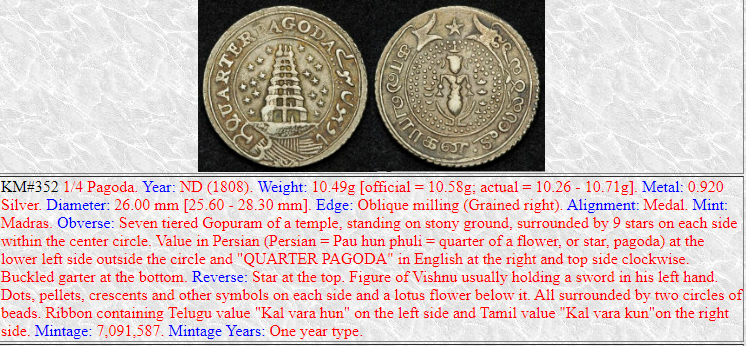
Hence, while the Madras presidency in the early 19th century had minted coins featuring the gopuram and Lord Vishnu, Alt News could not find a reference to any such coin issued by the East India company as shown in the viral images, purportedly bearing the figure of Lord Ram. The pictures in circulation represent fantasy creations.
Independent journalism that speaks truth to power and is free of corporate and political control is possible only when people start contributing towards the same. Please consider donating towards this endeavour to fight fake news and misinformation.

